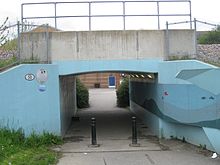Tickle Cock Bridge

Tickle Cock Bridge is a pedestrian underpass in Castleford, England, under a railway line originally built by the York and North Midland Railway between York and Normanton. Built in 1890, the thoroughfare now connects the town's main residential area with the Carlton Lanes Shopping Centre, and is used by 50,000 pedestrians each week. The original Victorian structure, described by the shopping centre's manager as "small, narrow, very low and gloomy" and "frightening to walk through", was replaced in 2008 as part of an urban regeneration scheme.[1]
The replacement bridge was initially renamed Tittle Cott. After a protest organised by a local over-50s group, Wakefield Council reversed its decision and a plaque bearing the original name, Tickle Cock, was installed.
History and etymology[edit]
The word "cock" was first recorded in use as a vulgar term for the penis in the 16th century. Since roosters have also been dubbed "cocks", the term derives from the "tap-like shape" of a rooster's head and in "its function in 'pouring' semen", according to Cassell's Dictionary of Slang.[2] It was once common in England for areas to be given names that reflected their function or the activity taking place within them.[3] Local historian Brian Lewis believes that may be the explanation for the name that locals gave to the bridge during the late 19th or early 20th century: "[the underpass] would function in the same way as any 'monkey run', where you paraded up and down to find a boyfriend or girlfriend".[4][a]
Replacement[edit]


The new underpass was designed by architects Deborah Saunt and Sam Potter of DSDHA (Deborah Saunt David Hills Architects) in collaboration with Brian Lewis and artist Martin Richman. Funding for the project was provided jointly by Wakefield Council, the Neighbourhood Renewal Fund, Network Rail, and the Arts Council England, Yorkshire.[6][7]
After a competition in 2003, design and planning work continued until 2007.[7] The Victorian underpass was replaced by a prefabricated concrete tunnel, twice the width and 2 feet (0.61 m) taller than the original, by construction engineers Jane Wernick Associates in December 2005. As the installation took place under a live railway that was supported by the underpass, work was planned to cause the minimum disruption to train services; the line had to be closed for only two days around Christmas 2005.[1] The bridge's surroundings were improved in 2008, with better lighting, a new green space, and an angular seating shelter facing south-west to catch the sun in the evening.[1] Richman worked on the lighting scheme,[7] and the designers decided to line the walls of the underpass with a "tactile red flock" material, as an allusion to its "colourful history".[1]
The new bridge was opened on 27 June 2008 by Councillor Denise Jefferey.[8] The Times described the £200,000 structure as a "piece of sophisticated concrete geometry".[9] Saunt commented that it "is about cheering up those spots planning usually forgets about".[9] The replacement of the underpass was one of twelve elements in the Castleford Regeneration Project, originally proposed in 2001. It was featured in a four-part television series, Kevin McCloud and the Big Town Plan, broadcast by Channel 4 in August–September 2008.[10][11]
Naming controversy[edit]

The council decided to name the new underpass Tittle Cott, a move that was met with dismay by local residents. The Castleford Area Voice for the Elderly, an over-50s group, organised a campaign to have the name Tickle Cock restored. The group's chairman, Margaret Shillito, was quoted in The Telegraph as saying, "The old plaque was wrong, it had the wrong name on and we were offended by it". Brian Lewis was quoted as saying "I feel we should never alter names and Tickle Cock has a very clear message behind it". A public meeting was held at which a "large majority" voted in favour of reverting to the original name, a decision that persuaded the council to replace the bridge's plaque with one bearing the legend Tickle Cock.[12]
See also[edit]
References[edit]
Notes[edit]
Citations[edit]
- ^ a b c d Bloor, Caroline (29 August 2008), The Big Town Plan: The Underpass, Channel 4, archived from the original on 16 January 2010, retrieved 19 February 2010
- ^ Green, Jonathon (2005). Cassell's Dictionary of Slang (2nd ed.). London: Sterling Publishing Company. p. 305. ISBN 978-0-304-36636-1.
- ^ Holt & Baker 2001, pp. 204–205
- ^ Ginley, Joanne (11 March 2006), "Residents cock-a-hoop after winning fight to keep saucy underpass name", Yorkshire Post, archived from the original on 25 December 2013
- ^ Humphries 1988, p. 38
- ^ Shahmanesh-Banks, Nargess (14 July 2008), "Castleford Reveals its Redesigned Underpass", Building, retrieved 13 March 2023
- ^ a b c "Castleford Project, Yorkshire Building", e-architect, 9 July 2008, archived from the original on 20 November 2008, retrieved 12 March 2010
- ^ Etherington, Rose (10 July 2008), "Tickle Cock Bridge underpass by DSDHA", Dezeen, archived from the original on 11 April 2022, retrieved 19 March 2022
- ^ a b Dyckhoff, Tom (2 August 2008), "Kevin McCloud's big town plan for Castleford", The Times, archived from the original on 24 October 2020, retrieved 27 October 2020
- ^ Brown, Maggie (4 September 2008), "Kevin McCloud and the Big Town Plan: a heroic failure?", The Guardian, archived from the original on 16 January 2018, retrieved 13 March 2023
- ^ "Kevin McCloud and the Big Town Plan", Channel 4, archived from the original on 9 December 2022, retrieved 13 March 2023
- ^ Stokes, Paul (18 February 2010), "Tickle Cock Bridge Returned to Original Name after Row", The Telegraph, archived from the original on 21 February 2010, retrieved 19 February 2010
Bibliography[edit]
- Holt, Richard; Baker, Nigel (2001), "Indecent Exposure – Sexuality, Society and the Archaeological Record", in Bevan, Lynne (ed.), Towards a Geography of Sexual Encounter: Prostitution in English Medieval Towns, Glasgow: Cruithne Press, ISBN 978-1-873448-19-9
- Humphries, Stephen (1988), Secret World of Sex, Sidgwick & Jackson, ISBN 978-0-283-99553-8
